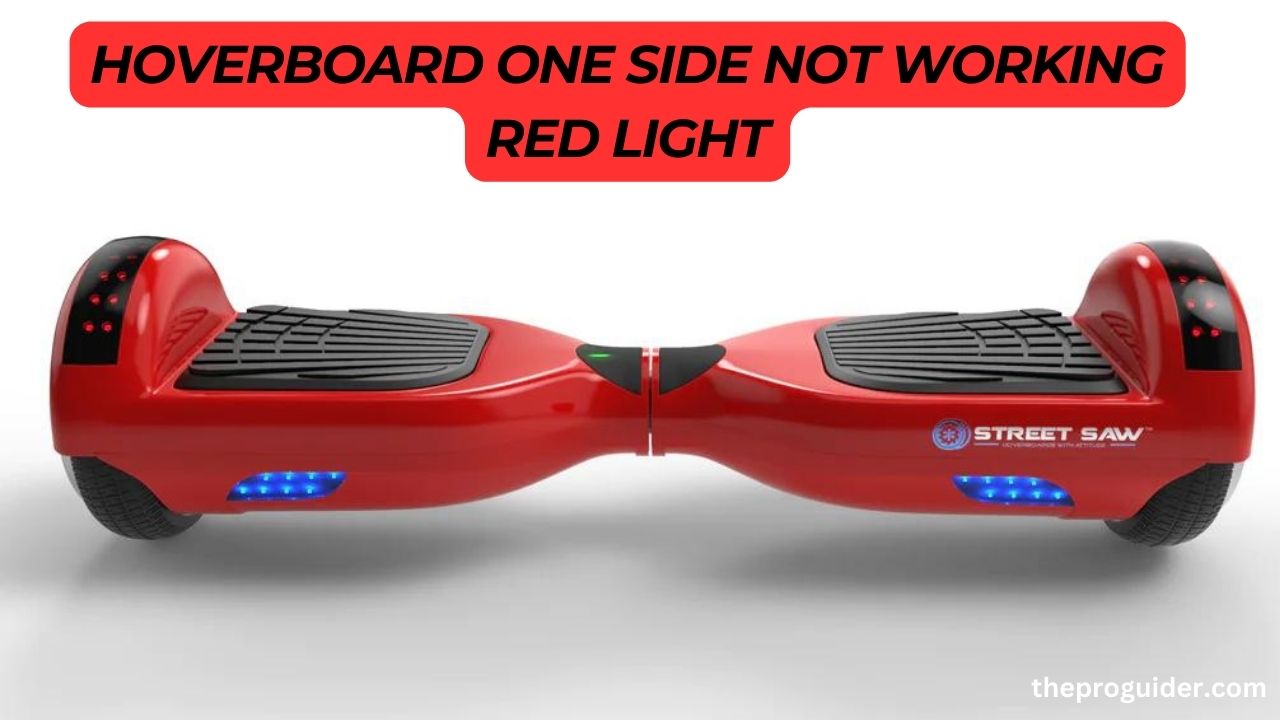Welcome to our guide on troubleshooting hoverboards! If you’ve found yourself here because one side of your hoverboard isn’t working and there’s a pesky red light, don’t worry we’ve got you covered. Hoverboards are awesome gadgets, but like any electronic device, they can sometimes run into issues.
In this simple and easy to follow guide, we’ll help you understand the basics of hoverboards, explore common causes for the “one side not working red light” problem, and walk you through step by step solutions. Let’s get started on getting your hoverboard back to its gliding best!
Table of Contents
TogglePossible Causes
Certainly! Here are the possible causes for the “one side not working red light” issue on a hoverboard:
Motor Malfunction:
The motor on the side with the red light may be experiencing issues. This could be due to loose connections or a burnt out motor.
Gyroscope Problems:
Hoverboards rely on gyroscopes for balance and stability. If the gyroscope on one side is faulty, it can cause the red light issue. Calibration problems or physical damage to the gyroscope could be the culprit.
Battery and Circuitry Issues:
The battery or circuitry on one side of the hoverboard may be faulty. This could be due to a low battery charge, faulty circuitry, or other electrical problems.
Understanding these potential causes can help pinpoint the issue and guide you in troubleshooting and resolving the problem with your hoverboard.
Step by Step Troubleshooting Guide
Here is a step by step troubleshooting guide to help address the “one side not working red light” issue on your hoverboard:
Initial Inspection:
- Turn off the hoverboard and visually inspect both sides for any signs of physical damage or loose components.
- Check the connections and cables leading to the side with the red light to ensure they are securely attached.
Motor Troubleshooting:
- Test each motor individually by disconnecting the power supply and manually spinning the wheels. If one side’s motor does not spin freely or makes unusual noises, it may be malfunctioning.
- Reconnect any loose wires or connectors associated with the motor. Make sure all connections are secure.
Gyroscope Calibration:
- Refer to your hoverboard’s user manual for instructions on calibrating the gyroscope.
- Typically, gyroscope calibration involves placing the hoverboard on a level surface and following specific steps to reset its balance sensors.
- Perform the calibration process carefully, ensuring that each step is completed correctly.
Battery and Circuitry Check:
- Check the battery level of your hoverboard. If it is low, recharge it fully and then retest the hoverboard.
- Inspect the circuit boards for any visible signs of damage, such as burnt components or loose connections.
- If you suspect a problem with the battery or circuitry, consider consulting a professional technician for further diagnosis and repair.
DIY Solutions:
- For minor issues such as loose wires or connectors, you can attempt to reattach them yourself using basic tools.
- Follow safety precautions and ensure the hoverboard is powered off before attempting any repairs.
Resetting the Hoverboard:
- Sometimes, a simple reset can resolve technical issues. Turn off the hoverboard, wait for a few minutes, and then power it back on.
- Ensure that the hoverboard is placed on a level surface during the reset process.
Seeking Professional Help:
- If you have tried the above steps and the problem persists, it may be time to seek professional assistance.
- Contact the manufacturer or a certified hoverboard repair technician for expert diagnosis and repair services.
By following these troubleshooting steps, you can identify and address the underlying issues causing the “one side not working red light” problem with your hoverboard. Remember to prioritize safety and cautious handling of electrical components throughout the troubleshooting process.

DIY Solutions
Here are some DIY solutions you can try to address the “one side not working red light” issue on your hoverboard:
Inspect and Tighten Connections:
- Turn off the hoverboard and carefully inspect all the electrical connections, including wires and cables, especially on the side with the red light.
- If you notice any loose connections, use a screwdriver or appropriate tools to tighten them securely.
- Ensure that all connectors are properly seated and there are no visible signs of damage or wear.
Check for Damaged Wires:
- Examine the wires leading to the side with the red light for any signs of fraying, cuts, or damage.
- If you identify any damaged wires, carefully strip the insulation and reconnect them using electrical tape or wire connectors.
- Be sure to insulate the connections properly to prevent short circuits or electrical hazards.
Clean and Maintain Components:
- Dust, dirt, and debris can accumulate inside the hoverboard over time, potentially causing electrical issues.
- Use a soft brush or compressed air to gently clean the internal components, including motors, circuit boards, and connectors.
- Avoid using water or liquid cleaners, as they can damage the sensitive electronics.
Inspect for Physical Damage:
- Carefully inspect the exterior of the hoverboard for any signs of physical damage, such as cracks, dents, or scratches.
- Pay close attention to the wheels, motor housings, and chassis for any structural issues that may affect functionality.
- If you discover any significant damage, consider consulting a professional technician for repair or replacement options.
Perform Basic Resets:
- Some hoverboards have reset buttons or procedures that can help resolve minor technical issues.
- Refer to your hoverboard’s user manual for instructions on how to perform a factory reset or reset specific components.
- Follow the recommended steps carefully to avoid causing further damage to the hoverboard.
Recharge and Test the Battery:
- Ensure that the hoverboard’s battery is fully charged before testing it again.
- Use the appropriate charger and allow sufficient time for the battery to reach a full charge.
- Test the hoverboard after charging to see if the issue persists.
By trying these DIY solutions, you may be able to troubleshoot and resolve the “one side not working red light” problem with your hoverboard. However, if the issue persists or you encounter difficulties during the troubleshooting process, consider seeking professional assistance from a certified repair technician or the manufacturer.
Tips for Preventing Future Issues
Preventing future issues with your hoverboard is essential for its longevity and your safety. Here are some tips to help you maintain your hoverboard and avoid encountering problems in the future:
Follow Manufacturer Guidelines:
- Always adhere to the manufacturer’s instructions and guidelines for charging, storage, and usage of your hoverboard.
- Refer to the user manual for specific recommendations regarding battery care, maintenance, and safety precautions.
Regular Inspections:
- Perform regular inspections of your hoverboard for signs of wear, damage, or loose components.
- Check the wheels, motors, chassis, and electrical connections for any abnormalities or issues that may require attention.
Keep it Clean:
- Regularly clean your hoverboard to remove dust, dirt, and debris that can accumulate over time.
- Use a soft cloth or brush to wipe down the exterior surfaces and avoid using harsh chemicals or abrasive cleaners that may damage the finish.
Store Properly:
- Store your hoverboard out of direct sunlight and extremely hot or cold conditions when not in use.
- Avoid storing the hoverboard in damp or humid environments, as moisture can damage the electronic components.
Avoid Overcharging:
- Do not leave your hoverboard plugged in for extended periods after it has reached a full charge.
- Overcharging the battery can reduce its lifespan and increase the risk of overheating or fire hazards.
Limit Extreme Conditions:
- Avoid riding your hoverboard in extreme weather conditions such as heavy rain, snow, or extremely hot temperatures.
- Exposure to moisture or extreme temperatures can damage the electrical components and pose safety risks.
Use Protective Gear:
- Wear appropriate safety gear, such as helmets, knee pads, and elbow pads, when riding your hoverboard.
- Protective gear can help reduce the risk of injury in the event of a fall or accident.
Avoid Rough Terrain:
- Stick to smooth, flat surfaces when riding your hoverboard and avoid rough terrain, uneven pavement, or obstacles that may damage the wheels or motors.
Regular Maintenance:
- Schedule periodic maintenance checks for your hoverboard, including battery tests, motor inspections, and software updates if applicable.
- Consider taking your hoverboard to a certified technician for professional servicing and repairs as needed.
By following these tips and adopting good maintenance practices, you can help prevent future issues with your hoverboard and enjoy safe and trouble free riding experiences for years to come.
Also Read: one side of hoverboard not working
Conclusion
In conclusion, taking care of your hoverboard is like looking after a good friend. By following simple steps like regular checks, keeping it clean, and storing it properly, you can prevent problems and ensure it stays reliable.
Remember to follow the manufacturer’s advice, avoid extreme conditions, and use protective gear for a safe ride. If issues arise, don’t hesitate to seek professional help. With a little care, your hoverboard will continue to bring joy and excitement without any red lights or troubles. Happy riding!
